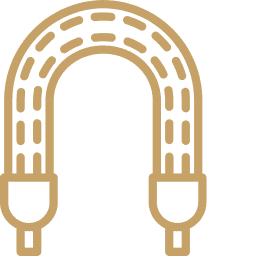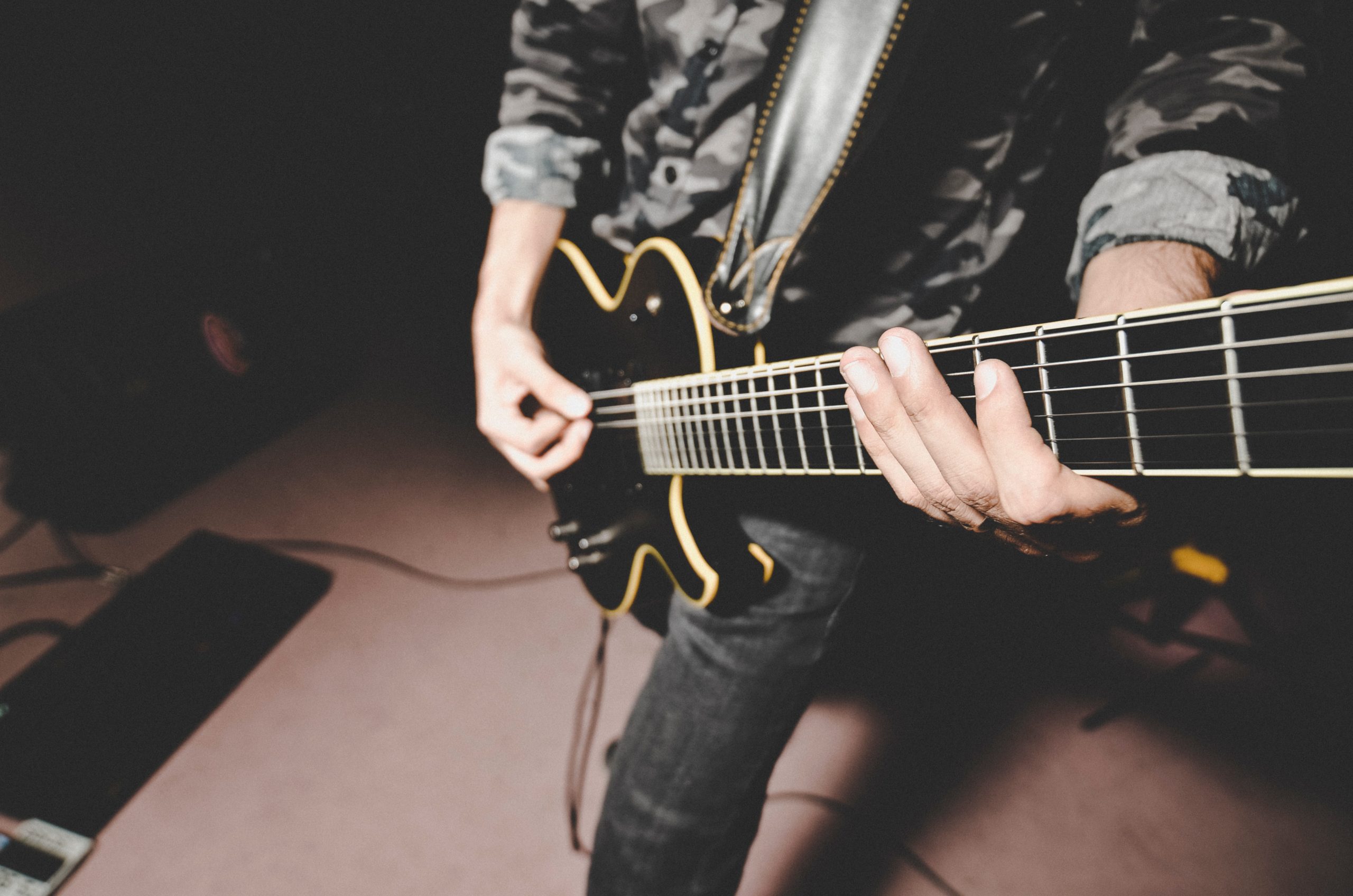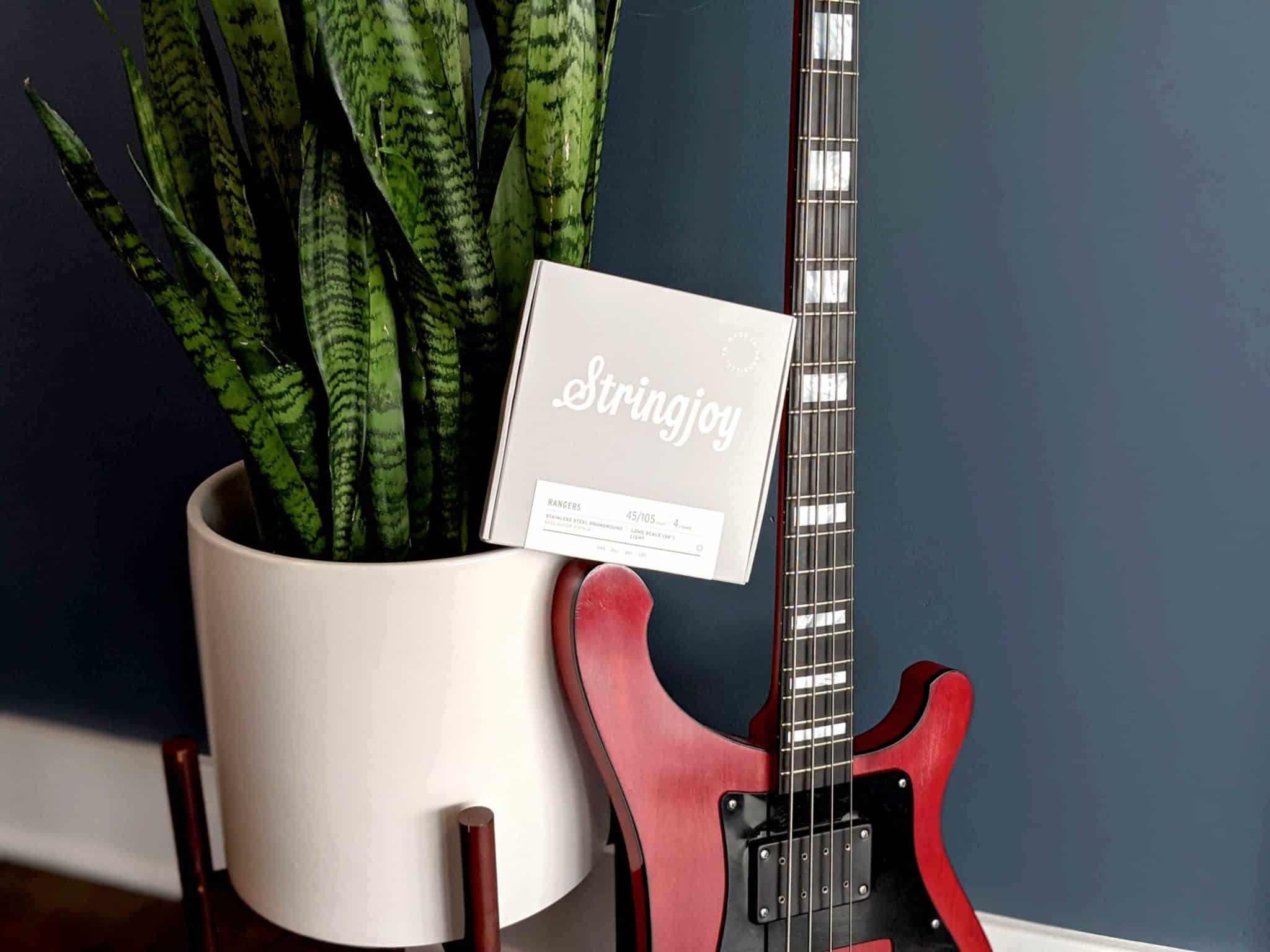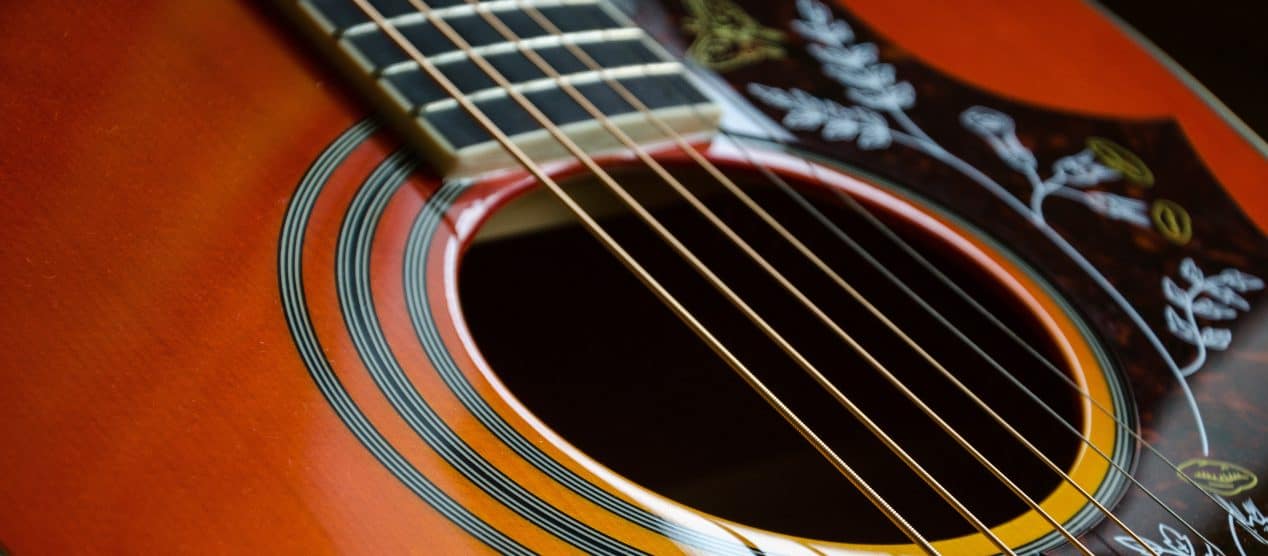In the world of guitar strings, perhaps no one is more influential than Stevie Ray Vaughan.
Most rockers in the 60s and 70s played fairly light strings, by today’s standards at least (both Jimmy Page and Jeff Beck were known to play .008 gauge strings, Hendrix played custom 9s and 10s). When Stevie came around, getting fatter tone than anyone had ever heard from a strat, everything changed.
Stevie came into the fold playing .013s, which at the time were pretty much unheard of outside of the jazz guitar world. Electric guitar pickups operate magnetically, so the more magnetic material vibrating above the pickups, the higher the output. Once players got a load of Stevie’s tone, they did everything they could to catch up, and a generation of heavy gauge players was born.
By now, SRV’s name is synonymous with super heavy strings, but there are a lot of misconceptions going around about what gauges he actually played, and what he had to do to make them work well on his guitar. Let’s clear a few of these up, shall we?
1. Stevie Ray Vaughan didn’t play just one kind of strings
Like most guitarists, SRV experimented with different string gauges throughout the course of his career (even going as high as .017s at one point!), but for the most part, he stuck with a high E of .013
2. He didn’t play “standard” .013s
In most cases, a standard set of .013 gauge strings is as follows:
.013 – .017 – .026w – .036 – .046 – .056
Thing is, SRV didn’t play a wound third. (Could you imagine playing his licks with a wound third? You’d have to have fingers like Thor.)
Like most pro players, SRV’s guitar tech Rene Martinez created a custom set of strings fit for his gear and his playing style. What were his actual gauges? We’re getting there, one step at a time!
3. He didn’t play with low action
Most solo-happy guitarists love playing with super low action, and for good reason. It’s easier to move quickly around the guitar, and it causes less fatigue. But anyone who has played heavy gauge strings will tell you that low action and heavy strings aren’t always compatible.
Thicker strings require a greater amount of space to vibrate properly. Even if it doesn’t sound like your strings are buzzing against the frets, they can still be restricted from vibrating fully, decreasing resonance and sustain. SRV kept his action high, enabling his strings to vibrate fully, and ring out for as long as possible.
4. He didn’t play in standard tuning
.013s are a feat to play no matter what, but in standard tuning, on a 25.5in scale guitar, they’re especially tricky. But SRV didn’t play in standard—he opted for Eb. Many say that this was more about his voice than his guitar (Great voice though he had, his upper register wasn’t exactly the selling point).
Still, .013s in Eb are much friendlier than in E standard, they play a lot closer to .012s (not that those are rinky dink strings in their own regard).
So what gauge strings did Stevie Ray Vaughan play?
According to Stevie’s tech, he most often played GHS Nickel Rockers (and sometimes Boomers) in the following gauges:
.013 – .015 – .019p – .028 – .038 – .058
If his fingers were aching, he would cut back to a .012 – .058 set, but for the majority of his career, his famous Number 1 and Lenny strats were strung up like this.
As discussed in point 2, these aren’t typical .013s—they’re lighter on the top end and a bit heavier on the bottom end. This made them easier to bend, while still giving him a hot and heavy tone when he played rhythm.
Now does this mean that if you string up your strat with these gauges you’re going to sound like SRV overnight? Probably not. As with most guitarists, the secret to tone often lies in the fingers.
Still, as much as guitarists analyze guitars, amps, and pedals—down to the core wood and circuitry—it’s surprising many players don’t put the same effort into finding the right strings. After all, that’s where it all starts.
So maybe you want to grab a set like Stevie’s and see what the fuss is all about? Or maybe you’d prefer to carve out your own custom gauges (Hey, maybe someone will even write about yours one day!). Either way, here at Stringjoy we specialize in giving you the tools and the freedom to make the most of your strings.
Watch the Video:

Video Transcription:
Stevie Ray Vaughan is one of the most legendary guitarists of all-time, and deservedly so. The thing is, over the years, his strings have gotten almost as legendary as he is.
The funny thing is, Stevie Ray Vaughan didn’t actually play just one set of strings. He actually played as light as 12s and as heavy as 17s at one point, but for most of his career, Stevie Ray Vaughan’s main guitars, his Number One and Lenny that are super legendary, were strung up with 13s—which is probably what you’ve heard of when you heard about Stevie Ray Vaughan’s guitar string gauges in the past.
What you may not have heard of is that Stevie Ray Vaughan’s 13s weren’t your normal 13s. If you go to a guitar store and ask for a set of 13s for electric guitar, the chances are, the gauges inside that set are going to look a lot like a set of 13s for acoustic. Most likely, they’re going to go something like 13, 17, 26 wound for the third string, 36, 46, and 56.
(Side note, Stevie Ray Vaughan is hardly the only famous guitarist to use a custom set of strings. Everyone from Jimi Hendrix to David Gilmore, Billy Gibbons, Tony Iommi, and many, many more have used very, very customized gauged sets of strings in order to dial in their setup for exactly how they play the guitar.)
Let’s talk about Stevie Rayn Vaughan’s guitar string gauges, because it was a lot different than that set of strings we talked about earlier. In order, his strings went from lightest to heaviest, 13, 15, 19 plain—so he’s not using a wound third—and then 28, 38, and 58 on the wound strings. That’s way different than the setup we talked about earlier.
Most notably, the second string through the fifth string in the set, at each of those positions, he’s using a way lighter string than you would typically see in a set of 13s. What does that do for him? It gives him a lot more flexibility on those old recordings, and you can hear it. He bends like crazy, and make no mistake, a 15 and a 19 are still pretty heavy strings to bend, but they’re not nearly the same as bending a 17 or a 26 wound.
In addition to that, on the very bottom of the set, he uses a 58 instead of a typical 56, which is interesting, because he has way lighter strings on the other wound strings. He has just a massive low E, which works really well for blues playing, where you’re often starting with that low E and then doing a riff on top of it.
In Stevie’s set, the only gauge of string that’s the same as a typical set of 13s is actually the 13 itself. Every other gauge of string is optimized one way or the other, whether it’s less tension or more tension, to better suit what his needs were at that particular position of the guitar.
In fairness, I should also mention that Stevie wasn’t playing in standard tuning. He was actually playing in E flat, down a half step across the board. This gives him a little bit more flexibility out of the same gauges of string than you would see in standard. (Make no mistake, these are still pretty heavy strings and not super easy to bend for any regular player, but it does help a little bit.)
The last thing we should talk about in regards to Stevie Ray Vaughan’s guitar string gauges is that he was actually playing with higher action than a lot of players typically do, which I think is interesting, because a lot of lead players seem to like to play with as low of action as humanly possible—where Stevie, who’s a really, really great lead player, really liked his action pretty high. This gives him a pretty clean, bell-like tone, no matter where on the guitar’s neck he’s fretting a note. It really, really sings out and really rings, and it also complements those really thick diameters of strings. As you can imagine, those take up a little bit more space from where they’re strung up, and this way, they’re not really interacting with the frets or getting any buzz or anything like that.
As with any discussion of string gauge, it’s worth taking these things with a little bit of a grain of salt, because the truth is, while Stevie Ray Vaughan had monster heavy tone, there are also a lot of guitarists that played eights or nines or nines that had really, really heavy meaty tone, as well. BB King, Jimmy Page, these guys played eights, and no one’s saying that their tone isn’t muscular and huge. If you do want bigger, fuller sound, heavier string gauges can get you a lot of the way there, and it might be something worth trying in your own rig.
What do you think? Are you going to jump straight up to a set of 13s like Stevie, or may just go with a set of 11s or even 12s? Let us know down in the comments. If you like this video, give it a like and be sure to subscribe to our channel to keep up with more great stuff just like this.








25 Responses
My neighbor, though riddled with personal problems and substance issues, was the best natural guitarist I had ever met.
He could pull off muscular bends in a way that puzzled me because he also had a subtle touch. His secret was always to play an acoustic first warming upplaying the same parts as electric.
It is a fact that it as SRV who unknowingly started this macho race of who plays with the thickest strings. Gladly I don’t fall prey to it, in fact, if you have a list of the best electric players of all time, most use 9’s, and 10’s. No need to work so hard for good tone and good songs.
I was fortunate to see Stevie at the Universal Ampitheater a couple years before he died. His tone in the room was ICEPICK bright. So loud and piercing I had to go for the tissue in the ears. Either Stevie was partly deaf or his soundman was. I have played in Rock Bands for 45 years, I know good loud and icepick loud.
SRV used super glue on his finger tips that way he could handle heavy strings
thats not why he used super glue…he glued his callus back on because when you play for so long sometimes they can rip off and then you have to wait a few weeks to completely regrow it enabling ghost notes and more unwanted things to happen. It wasn’t so he could handle it. I have been playing for about 14 years now. And i have always tuned low, kept my action high, used heavy top skinny bottom gauge strings. and it took some getting used too. For MONTHS i had to excersise my hand and fingers so i could build the strength to maintain my endurance and stamina during a live performance. Its quite embarrassing when your finger just gives out in the middle of a solo.,
I played for years in a band that did three sets a night four or five nights a week using .15-.17-.19p-.38-.48-58 . It was fun watching people sit in and borrow my guitar…
I strung up my strat with .13s a couple times through life thinking I could sacrifice playing ability for tone. Played a terrible show because I could hardly play my guitar, combined with actually giving a show and trying to play my fingers started fatiguing hard. Never heard back from the venue owner…
I now play .10-.38 and can hold down a gig xD
Way back when I first got into TRYING to play like Stevie, I started with playing 11’s and going back and forth between standard and a half step down tuning. Then moved up to 12’s. I played in a fairly traditional swing band at the time and had to play in standard tuning. Long story short, although it was “fun” to think I was on the right path for “tone”, it ended up causing wrist issues that took a long time to overcome…I’m now happy with standard 10 sets. I wish I would have read this information years back! Haha
Great stuff. Surprised you left out most interesting SRV strings fact. When starting out and practicing , he strung his guitar w bass strings. Then after practicing for hours , switching to regular guitar gauge was like a walk in the park. Genius !!! A true legend. Guitar and vocals. RIP SRV
I actually kind of started this way on accident. I had this electric guitar but no amp. So I gutted the guitar and just strung it with some strings I purchased which turned out to be acoustic strings. A bitch to play, but when I finally got my first “real” guitar, it played like butter cause my fingers were very strong back then. 😉
Im pretty sure he just did what a lot of us guitar players do before studio sessions or live gigs or even band practice. We just take our bassists Bass guitar and play it for about an hour. all the scales warms ups chords and everything. you can’t put bass strings on a guitar. I mean, technically i guess you could, depending on the strings and guitar. but on a Fender with Tommy Shannons strings? na aint happening lol.
Stringjoy, you say:
“Thicker strings require a greater amount of space to vibrate properly. ”
I believe the above is incorrect.
To achieve the same pitch with thicker strings require higher tension. A .012 string tuned in E will be tighter than a .009 string tuned in E and while vibrating it will not move far from its centre. If you notice light strings they vibrate very loosely and they require a greater amount of space from the frets in order not to buzz.
Try any expensive jazz guitar and you will see that with heavy gauge strings you can get away with very low action (i.e. in jazz guitar you normally have very heavy strings that are very close to the frets without buzzing).
The reason why SRV may have had high action was because he hit the strings very strongly so he had to have high action to avoid buzzing.
Very interesting. The string tension is determined by the bridge to the tuner not the bridge to the nut as all string manufacturers use. So if you use a string tension calculator (stringtensionpro.com) you’ll find out that those gauges are basically a set of 11s with a 13 1st string… tuned down a half step so they actually have the tension of 10s! but with a 12 on top. That’s nothing! I play custom 10-54 sets on my strat in standard tuning so I basically have the same tension as Stevie except for his 1st string.
Hey Clint — you’re right about some things here. In theory, the length behind the nut affects string tension, but this depends on the degree to which a particular nut creates friction and resistance on the string passing over it, and that my friend is quite hard to measure (and it has a minuscule effect on the overall tension). That’s why we and every other string manufacturer use bridge to nut length “Scale Length” for calculating string tension.
As for the gauges, again, sort of. It’s really a set of 11.5s with a 13 on top, which tuned down a half step would feel like a set of 11s with a 12.5 on top. But moreover, you’re correct in that the trick of SRVs gauges is that they’re not all that heavy in the places where he made a lot of bends.
Final note, I’d avoid using stringtensionpro, it’s a fairly clunky and inaccurate piece of software. You can sit there and notch up the individual string gauge and watch as it doesn’t change the overall tension one bit…
I would snap anything less than a 13 and the way srv bent strings had to be the reason.
I went ahead and gave these gauges a try on a Mexican strat I had lying around. Long story short, I get it. Not nearly as difficult to bend as some sets of 13s I’ve played, and that 58 on the bottom really gives you some power for E heavy blues rock.
Awesome! You guys rock! I recently put your strings on my guitar (11-1/2s) and I love them! I was reaching for a fatter SRV tone and I must say their perfect! Not too big of a jump from my usual 11s but a definite difference in tone a little bit and a whole different feel. Maybe it’s your superb quality control?? All in all reality really happy and will recommend to friends!! Keep up the good work! Thank you!
You guys are the coolest string company ever. Great strings, personal touch, and fun reads, just cool.
Hey guys, OK … That’s the Electric End of things … How about his Gauges on his acoustics? Did he leave us any historical documentation as to what he used there? I am sure they had to had been Monsters!
Great question! We can’t find any info on his acoustic strings, hopefully some will turn up somewhere!
Sorry… You got the gauges right, but wrong strings. He played GHS Nickel Rockers, not Boomers.
Good eye! You’re correct about the Nickel Rockers, though he also used Boomers on occasion as well. Fixed it in the article. Thanks for the head-up!
There’s also how the added magnetic mass of the strings coaxes a little more output from the pickups, reinforces the lower harmonics of the strings, and uses the subtle inharmonicity of a struck metal bar (which a string technically is, however small) to add some clank to the sound, which is helpful if you’re gonna play some high-energy Strat-n-Tweed/Silverface tones. Tube Screamer optional (but helpful).
My name is Jerry Fox. I drove Stevie four nighs before he went on tv when Mick Jagger was on with Gerry Hall on SNL. He said he used “black face” 12″ ( I believe) to get the sound he liked. Sometimes it’s not just the strings .
Jerry Fox
Former President of
FOX Limousines
Oh it’s never *just* the strings, if it were that would be a heck of a lot easier 🙂